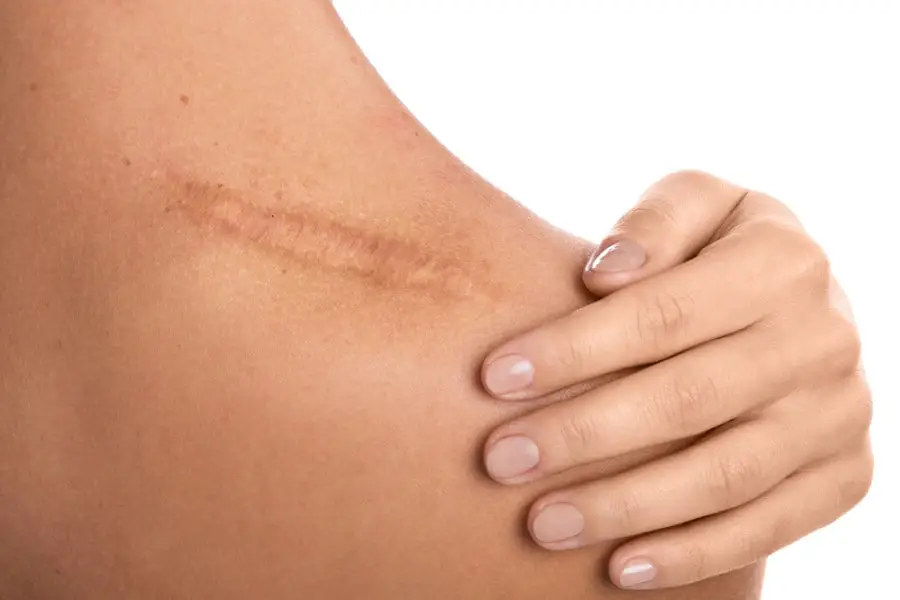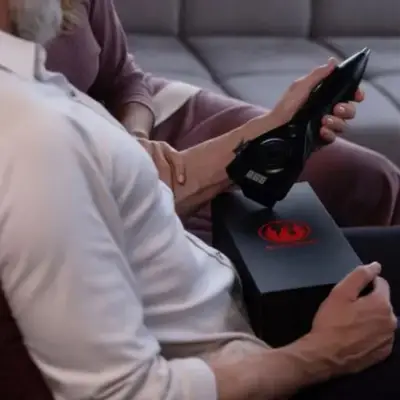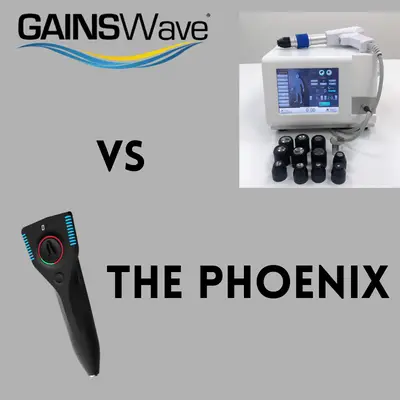You’ve probably found that a scar following an injury or surgery can restrict movement or cause pain, interfering with your normal activities. You may have heard that electrical stimulation could improve the flexibility of scar tissue—and you’re also aware that TENS is a form of this treatment that is both convenient and inexpensive
So, does a TENS unit break up scar tissue? Probably not, although it can be useful in treating the pain that is often associated with scar tissue. Studies haven’t been conclusive, but it’s thought that the electrical current delivered by TENS is too high to be effective for breaking up scar tissue.
Well, that probably raises more questions than it answers. So, let’s look into it in more detail, and also explore a form of treatment that could help with your problem.
What Is Scar Tissue?
Let’s start with the basics and explain how scar tissue forms, why it’s a problem, and how it’s normally treated.
How Does Scar Tissue Form?
Scar tissue can appear after an injury or after surgery. You’re probably already familiar with scars on your skin. However, scar tissue can also be internal. One example is its formation following an injury to or surgery on a muscle or tendon.
Scars are just part of your body’s natural healing process. Like the rest of your skin and soft tissue, they’re made up of collagen.
Your body’s response to injury is to heal the damaged area as quickly as possible. It does this by rushing collagen fibers to the injury site to replace those that have been damaged. However, these fibers aren’t arranged as nicely and neatly as the original fibers. Speed, rather than aesthetics, is the priority.
Why Is Scar Tissue a Problem?
You’ll have noticed that a scar on your skin doesn’t look or feel the same as the original skin or the skin around it. It’s the same for scars that form on muscles or tendons.
The collagen fibers making up scar tissue are less flexible than the original. That’s why scars can restrict movement and reduce functionality, possibly causing pain in the process.
How Is Scar Tissue Treated?
Where scar tissue impedes movement, the aim of treatment is to loosen up the tissue to increase the range of motion.
Massage is commonly used to achieve this once a scar has healed. Massage aims to increase blood flow to the area and release hormones that induce feelings of well-being.
Also, the physical manipulation of the area is thought to set off chemical reactions that may help restructure the fibers in the scar tissue. This may improve the elasticity of that tissue, increasing movement, and reducing pain. However, the scientific basis for the effectiveness of scar massage isn’t conclusive.
Additionally, massage inevitably involves applying some sort of pressure to, or manipulation of the affected area. This can be painful or uncomfortable, so it may not be something you want to try.
It’s also not something you can always do yourself at home, so it can be inconvenient and expensive.
Is TENS a Solution?
What Is TENS?
TENS is a method of pain treatment that acts by blocking pain signals that would otherwise reach your brain.
It uses a mild current produced by a TENS unit, a small device that’s attached to gel pads that you apply to your skin. The gel pads conduct the current from the TENS unit to your skin, stimulating your sensory nerves.
As a result of this stimulation of your nerves, non-pain messages are produced, and they prevent pain messages from reaching your brain.
The scientific theory behind TENS as a treatment for pain seems to be accepted. However, it doesn’t work for everyone or for all pain.
Nevertheless, it’s still viewed as being a useful form of pain control, even if only as a part of a wider treatment program. This is because it works for some people and carries little risk of side effects.
Will a TENS Unit Break Up Scar Tissue?
As you’ve read above, TENS is a form of pain relief. Additionally, a 2013 study suggested that TENS might assist in the wound healing process.
Want to know where a TENS unit can be placed? Check out my TENS placement guide here
TMJ Pain and more!
So Electrical Stimulation Doesn’t Help the Breaking Up of Scar Tissue?
Well, there’s no evidence that TENS will help to break up scar tissue.
However, there’s a TENS-like form of electrical stimulation that‘s thought to be capable of doing so. It’s called microcurrent therapy, and we’ll explain it in greater detail below.
What Is Microcurrent Therapy?
Microcurrent therapy is similar to TENS in that it makes use of an electrical current generated by a device similar to a TENS unit.
Also, the devices are relatively cheap and can be bought for home use. Additionally, there’s little risk of side effects.
What’s the Difference Between TENS and Microcurrent Therapy?
It’s not surprising you ask, as it does seem confusing given that both make use of electrical currents applied to the skin.
Well, the difference between these two treatments comes down to the strength of the electrical current used.
A TENS unit uses currents that are a thousand times stronger than the current used in microcurrent therapy.
Microcurrents are so tiny that you can’t feel them, just as you can’t detect the electrical currents naturally flowing through your body. They fall below the threshold of your senses.
In contrast, you’ll feel at least a tingling sensation from the current generated by a TENS unit. After all, that’s the point of it: to stimulate your sensory nerves. So, the strength of this current means it plays a different role from the microcurrents flowing through your body.
This difference in the strength of the current is crucial to the distinct effects of these forms of electrical stimulation.
How Does Microcurrent Therapy Work?
You’d be forgiven for thinking that your body is just a collection of chemical processes given the focus of traditional medicine on drug therapies.
That’s not all there is, though. Alongside the chemical processes, electrical currents circulate within your body. These bioelectrical processes, like an electrical circuit board, involve electrical currents passing through the cells and tissue.
These natural electrical currents are in the microcurrent range, the same as that generated in microcurrent therapy.
The currents flowing through your body are a vital part of your body’s internal processes. When an injury occurs, one of those processes, healing, kicks in to repair the damage done.
As you’ve read above, the priority is speed, which means that tissue quality is compromised, resulting in scar tissue forming. The density of the fibrotic scar tissue disrupts the normal flow of the currents through the affected area.
Consequently, the presence of an important molecule produced by these currents, ATP, is reduced. As it’s responsible for moving nutrients in and out of cells, a lack of it can weaken the affected area.
Additionally, the taut scar fibers can act as a pull on the surrounding tissue or muscle, restricting normal functionality.
So, microcurrent therapy mimics and boosts your body’s natural electrical currents allowing them to force their way into the scar tissue. This increases the level of ATP in the scarred area, restoring the movement of nutrients.
With electrical currents and nutrients flowing again, your natural restorative process is resumed. In effect, the scar tissue is broken down and restored to a healthier, flexible state, improving the range of movement.
Conclusion
So, scientific support for TENS in breaking up scar tissue is lacking. It may assist the process of healing, which could improve the quality of resulting scar tissue, reducing subsequent problems.
However, to break up problematic scar tissue once it’s formed, the use of microcurrent therapy seems to be supported by scientific evidence. So, it’s worth considering with appropriate medical advice.
Sources
- Wikipedia: Scar
- Nhs.uk: TENS
- Uihc.org: TENS
- S3.amazonaws: Frequency Specific Microcurrent
- Wikipedia: Wound Healing
- Britishskinfoundation: The Benefits of Scar Massage
- ncbi.nlm.nih.gov/pubmed: The Role of Massage in Scar Management
- ncbi.nlm.nih.gov/pmc/articles: The Effectiveness of Transcutaneous Electrical Nerve Stimulation for Treatment of Hyperalgesia and Pain
- Ncbi.nlm.nih.gov: Transcutaneous Nerve Stimulation
- Tandfonline: Electrical Stimulation to Accelerate Wound Healing
- Wikipedia: Microcurrent Electrical Neuromuscular Stimulator
- Frontiersin.org: Nature’s Electrical Potential: A Systematic Review of the Role of Bioelectricity in Wound Healing and Regenerative Processes in Animals, Humans, and Plants
- Wikipedia: Bioelectricity
- Wikipedia: Fibrosis
- ncbi.nlm.nih.gov/pubmed: The effects of electric currents on ATP generation, protein synthesis, and membrane transport of rat skin
- Magonlinelibrary: Treatment of symptomatic abnormal skin scars with electrical stimulation
- ncbi.nlm.nih.gov/pmc/articles: The effects of transcutaneous electrical nerve stimulation on tissue repair: A literature review
- Heighpubs.org: Frequency specific microcurrent resolves chronic pain and adhesions after ulnar transposition surgery
- Dynamicchiropractic: How Microcurrent Stimulation Produces ATP — One Mechanism
- ncbi.nlm.nih.gov/pmc/articles: Microcurrent Electrical Neuromuscular Stimulation Facilitates Regeneration of Injured Skeletal Muscle in Mice





4 responses to “Does a TENS Unit Break Up Scar Tissue?”
[…] your doctor or medical professional know. If you happen to place the electrode over an area of scar tissue it can cause increased skin resistance and a decrease in the effectiveness of the TENS u… […]
[…] reading to learn more about dissolving scar tissue and how to use a massage gun to break it […]
[…] with these components, or TENS units in general, this setup list might seem like gibberish. Let’s break things down and briefly explore the details of the TENS unit […]
[…] of the Scar Tissue in the […]